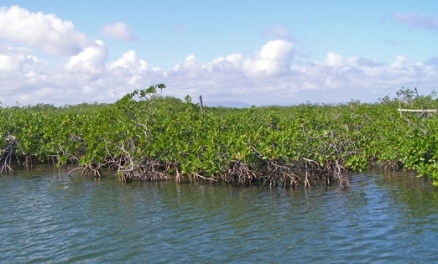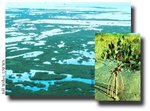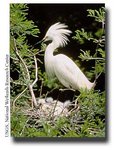Mangrove (Biodiversity)
Contents
Mangrove
A Mangrove plant association is a type of specialized coastal wetland found in tropical and subtropical regions. This ecological community is characterized by halophytic (salt loving) trees, shrubs and other plants growing in brackish to saline tidal waters. These wetlands are often found in estuaries, where freshwater meets saltwater and are infamous for their impenetrable maze of woody vegetation. A mangrove swamp is inherently a depositional anoxic environment.
In North America, they are found from the southern tip of Florida along the Gulf Coast to Texas. Florida's southwest coast supports one of the largest mangrove swamps in the world. Extensive mangrove systems are found in the Caribbean and Indo-Pacific regions.
Flora
There are approximately 110 distinct species of basic mangrove trees or shrubs, in addition to numerous vegetative associates; however, mangrove ecosystems are among the least florally diverse of all biomes. Locales in Malasia and New Guinea are superior to other world regions in floral biodiversity.
Mangrove trees dominate this wetland ecosystem due to their ability to survive in both salt and freshwater. In the continental United States, only three species of mangrove grow: red, black, and white mangroves. Red mangrove (Rhizophera mangle) is easily recognized by its distinctive arching roots. Black mangrove (Avicennia sp.), which often grows more inland, has root projections called pneumatophores, which help to supply the plant with air in submerged soils. White mangroves (Laguncularia racemosa) often grow even farther inland with no outstanding root structures. A greater diversity of mangrove species is found in the Indo-Pacific region.
Fauna
A wide diversity of animals is found in mangrove swamps. Since these estuarine swamps are continually replenished with nutrients transported by fresh water runoff from the land and flushed by the ebb and flow of the tides, they support a bursting population of bacteria and other decomposers and filter feeders. These ecosystems sustain billions of worms, protozoa, barnacles (Balanus spp.), oysters (Crassostrea spp.), sponges, and other invertebrates, some of which live attached to the roots. These organisms, along with those living in the mud at the bottom, in turn feed fish and shrimp, which support wading birds, pelicans, and the much endangered crocodile. Many fish species that live as adults on coral reefs live in mangroves as juveniles. Mangroves are sometimes referred to as "nursery habitats" for these species, and their presence increases the populations of these fish on the nearby reefs. Other species of fish inhabit mangrove areas for their whole life cycle.
Function and Disturbance Regimes
The importance of mangrove swamps is well established in regard to shoreline erosion control and ecological productivity. They function as nurseries and adult habitat for shrimp and recreational fisheries, exporters of organic matter to adjacent coastal food chains, and enormous sources of valuable nutrients. Their physical stability helps to prevent shoreline erosion, shielding inland areas from severe damage during hurricanes and tidal waves.
There are several basic disturbance regimes to mangrove habitats: hurricanes, lightning strikes, tsunamis, tidal waves and frost. Frost is only relevant at the very highest latitudes such as Texas and northern Florida. Tsunamis are the least frequent disturbance, but potentially the most devastating; they are more likely in certain regions such as the Indian Ocean, and less likely in others such as the Caribbean Basin. Tidal waves may occur in severe storms, but usually accompany only the most severe events such as hurricanes or intense tropical storms. Lightning strikes comprise the most surgical of disturbances, but are an important part of the varied mosaic of a mangrove swamp, by encouraging a cleared section of the mangroves, where regrowth is stimulated and different species are accommodated during the regrowth period.
Example Ecoregions
The following are example world ecoregions that are dominated by mangrove species:
- Bahamian mangroves
- Belizean coast mangroves
- Bocas del Toro-San Bastimentos Island-San Blas mangroves
- Gulf of Panama mangroves
- Indochina mangroves
- Petenes mangroves
- Ria Lagartos mangroves
- Sunda Shelf mangroves
Conservation Status
As these [[wetland]s] are increasingly threatened by coastal development and the expanding human population, as well as damming of upstream freshwater sources, significant decline in their integrity and productivity has been observed. Mangrove swamps have experienced considerable human destruction since the 1950s. In some countries mangroves are cleared to make way for shrimp aquaculture facilities to feed the burgeoning human population; in other cases the mangrove shorelines have proved to be attractive locations for tourism and residential development, leading to construction of hotels and condominiums. However, some limited efforts are underway to enhance the protection of these valuable ecosystems. It was clear after the Indian Ocean tsunami of late 2004 that areas that still had intact mangroves along the coast were less damaged than areas from which the mangroves had been removed.
References
- Daniel M.Alongi. 2009. The energetics of mangrove forests. 216 pages
- Les Beletsky and David Beadle. 2005. Belize & Northern Guatemala. Interlink Books. 477 pages
- Luiz Drude de Lacerda. 2002. Mangrove ecosystems: function and management. Springer. 292 pages
- Alistar I.Robertson and Daniel M.Alongi. 1991. Tropical mangrove ecosystems. American geophysical Union. 329 pages
- P.Saenger. 2002. Mangrove ecology, silviculture, and conservation. Springer. 360 pages
| Disclaimer: This article contains some information that was originally published by the Environmental Protection Agency. Topic editors and authors for the Encyclopedia of Earth have edited its content and added new information. The use of information from the Environmental Protection Agency should not be construed as support for or endorsement by that organization for any new information added by EoE personnel, or for any editing of the original content. |



